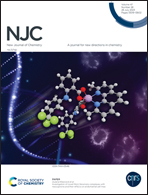Oxygen-phosphorus-codoped graphitic carbon nitride nanosheets with better photocatalytic ability towards the degradation of rhodamine-B dyes†
Abstract
A unique oxygen-phosphorus-codoped graphitic carbon nitride (O,P-GCN) was prepared through the thermal decomposition of urea, oxalic acid, and ammonium phosphate. The O,P-GCN photocatalyst was used for the degradation of rhodamine B (RhB). The higher photocatalytic activity of O,P-GCN was attributed to its nanostructure with porous properties and the doping of oxygen and phosphorus, which created more electron–hole pairs and improved its electron transfer efficiency. Additionally, the porous nature of the prepared O,P-GCN led to more reactive sites for the target pollutant degradation. The structure, morphology, and optical properties of the material were confirmed using XRD, FTIR, XPS, FE-SEM, UV-Vis, and PL techniques. The doping agent of oxygen atoms in GCN tri-s-triazine expanded the light absorption significantly in the visible range. During the photocatalytic process, various kinds of reactive species were generated such as hydroxyl radicals, superoxide radicals, electrons and holes. The results of the free radical scavenging experiment showed that active free radicals played a critical role in the photocatalytic degradation of RhB. Therefore, this study demonstrated a simple, environmentally friendly, and cost-effective technique for preparing porous nano-sheets of O,P-GCN by incorporating oxygen and phosphorus doping provided by oxalic acid and ammonium phosphate into the GCN lattice. The synthesis of O,P-GCN was confirmed by XRD, TEM, XPS, and other analysis techniques. We found that the addition of 1 wt% oxygen and phosphorus in GCN significantly improved its photocatalytic performance, and the efficiency of RhB removal could reach up to 97.25%.



 Please wait while we load your content...
Please wait while we load your content...